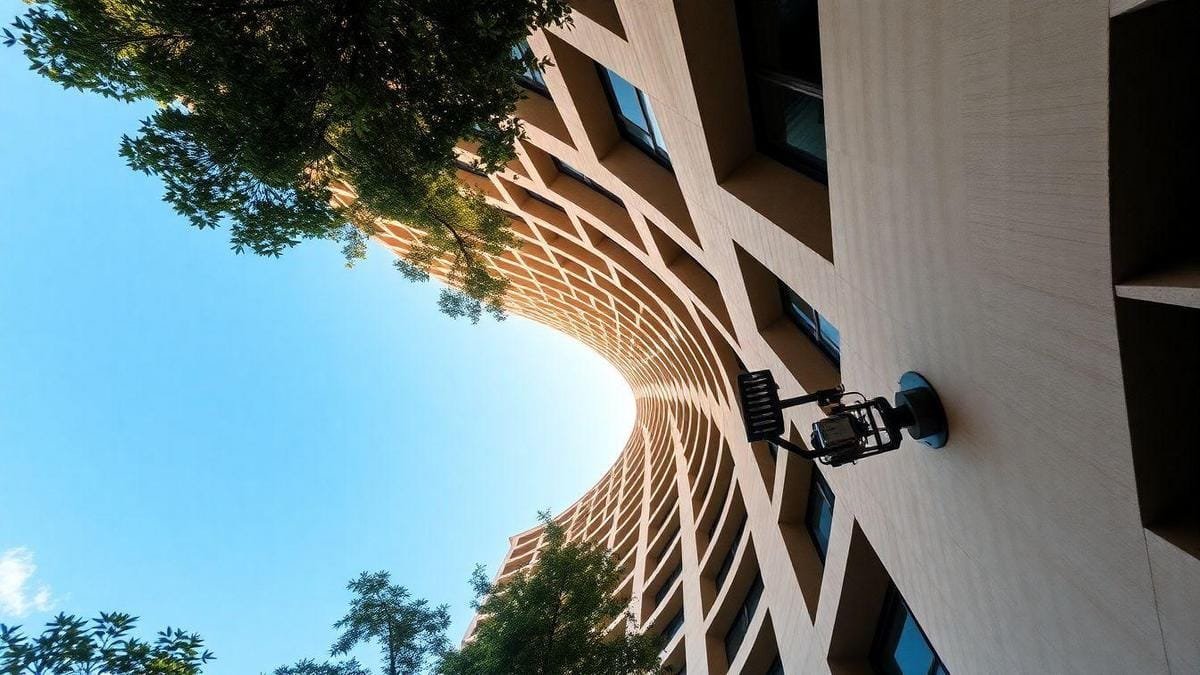Listen to this article
Technology used in the construction of the Copan Building and its impacts is what you'll discover in this article. Get ready to explore how this construction site has become an icon of São Paulo, full of architectural innovations that have changed the way we think about modern design. You will understand the Oscar Niemeyer's visionthe impact of sustainability and learn about the challenges that engineers have faced. In addition, we will discuss the costs and construction timeand what this beauty teaches us about the future of construction in Brazil. Let's go?
Main conclusions
- The Copan Building has a unique design.
- It was designed by Oscar Niemeyer, a renowned architect.
- It used concrete in an innovative way.
- The shape of the building resembles a wave.
- It is an important symbol of the city of São Paulo.

The Architectural Innovation of the Copan Building
What makes the Copan Building unique?
O Copan Building is a true masterpiece of São Paulo. With its sinuous and impressive shape, it stands out in the urban landscape. Its structure is made of reinforced concrete, ensuring stability and allowing the curvature you see. It also has more than 1,160 apartmentsIt became one of the largest residential buildings in Brazil.
Here are a few facts on the costs and impacts of construction:
| Aspect | Details |
|---|---|
| Construction costs | Approximately R$ 8 million |
| Construction time | 4 years (1951-1957) |
| Environmental Impact | Use of local materials |
Oscar Niemeyer's vision in construction
Oscar Niemeyer, the genius behind Copan, had a clear vision: to create a space that was functional and beautiful. He believed that architecture should flow with nature. The Copan Building is a perfect example of this, as its curves resemble the shapes of the mountains and the sky.
Niemeyer focused on natural lighting and ventilation, making the apartments more pleasant. This shows how technology used in the construction of the Copan Building and its impacts go beyond what the eye can see.
The importance of modern design
Modern design is crucial to making spaces more comfortable e practical. In the case of Copan, the use of large windows lets in light, creating a cozy atmosphere. The layout of the apartments has been designed to maximize space, something you would certainly appreciate when living there.
Niemeyer didn't just design a building, he designed a symbol of the city. He wanted people to feel good when they entered and left, and that's something Copan does masterfully.
Technology in construction and its impacts
How technology has changed construction
A technology revolutionized construction! Before, everything was done by hand and took a long time. Now, with new tools and machines, projects are completed more quickly and with better quality. The use of 3D printers to create structures helps save time and materials. A Building Information Modeling (BIM) allows you to plan everything in detail before starting work, giving you a clear vision of the end result.
Examples of innovations in other famous works
Many buildings in Brazil and around the world use cutting-edge technology. One example is the Maracanã Stadium, which has undergone an incredible renovation with the use of modern technologies, such as solar panels and rainwater harvesting systems. Another example is Museum of Tomorrow in Rio de Janeiro, designed with a system of automation to control temperature and lighting, ensuring comfort and efficiency.
| Work | Technological Innovation | Impact |
|---|---|---|
| Maracanã Stadium | Solar panels and water harvesting | Cost reduction and sustainability |
| Museum of Tomorrow | Temperature and lighting automation | Comfort and energy efficiency |
What we can learn from the Copan Building
O Copan Building is an icon in São Paulo and provides lessons on how technology can impact construction. Designed by Oscar NiemeyerThe building is not only beautiful, but also functional. Its design optimizes ventilation and natural lighting, reducing the need for air conditioning and electric lighting. This shows that, in addition to aesthetics, technology can create more functional spaces. sustainable e comfortable.

Sustainability in the construction of the Copan Building
Sustainable materials used on site
When we talk about Copan BuildingWe immediately think of its iconic shape and historical importance. But did you know that sustainability is also part of this story? During construction, sustainable materials such as recycled concrete and reforested wood, helping to reduce environmental impact and preserve our natural resources. This is an example of how construction can help with climate mitigation.
How sustainability impacts the environment
Sustainable construction is not just a fad, it's a need! The Copan Building was designed to minimize waste and maximize efficiency, consuming less energy and water, which is great for our planet. This type of construction also improves air quality and urban space, making the city more pleasant for everyone. For more information on this topic, check out the importance of sustainable construction.
The importance of green buildings
Green buildings like the Copan Building are essential for a better future. They help combat climate change and protect biodiversity, as well as bringing economic benefits such as reduced energy costs. Investing in sustainability is an important step towards ensuring that future generations have a beautiful and healthy place to live.
Costs involved in the construction of the Copan Building
The original budget and actual spending
When we talk about Copan BuildingWe started with a budget that seemed relaxed. The initial project, in the 1950s, had an estimated cost of around 2 million cruzeiros. In the end, the total cost came to 33 million cruzeiros! Construction lasted from 1951 until 1966, and many factors influenced the cost, such as the financial management.
Comparison with other works in São Paulo
Comparing Copan with other buildings in São Paulo, the difference is striking. O Italy Building, another city landmark, also cost a lot, but nowhere near as much as Copan. Here's a quick table for you to see:
| Building | Original Cost | Final Cost |
|---|---|---|
| Copan Building | 2 million | 33 million |
| Italy Building | 1.5 million | 25 million |
What influences construction costs?
Construction costs can be influenced by several factors. Let's list some of them:
- Materials: The price of materials may vary.
- LaborThe salary of workers and the availability of qualified professionals.
- Technology: The use of new technologies can increase or decrease costs.
- TimeThe longer the work takes, the more expensive it is.
These aspects are fundamental to understanding why the Copan Building cost so much.

The construction time of the Copan Building
How long did it take to complete the work?
O Copan Buildingone of São Paulo's icons, took about 3 years to be completed. Construction began in 1951 and was finalized in 1954. Thousands of workers labored hard to erect this marvel of architecture, which today is a symbol of the city.
Factors affecting the construction schedule
A number of factors had an impact on Copan's construction time. Let's take a look at some of them:
- Weather conditionsDays of rain and strong winds delayed the work.
- Project changes: The architect Oscar Niemeyer made adjustments throughout the work, which created more time.
- MaterialsThe availability of materials at the time also influenced the pace of the work.
Here is a table showing these factors:
| Factor | Impact on Schedule |
|---|---|
| Weather conditions | Frequent delays |
| Project changes | Increase in total time |
| Availability of materials | Work interruptions |
Lessons on deadlines in large projects
Looking at Copan, we can learn valuable lessons about deadlines in large buildings. One of the main ones is that flexibility is crucial. Large projects always have unforeseen events. In addition, good planning and communication between the team can help avoid surprises.
And remember: patience is a virtue. Great buildings like this don't happen overnight. Every brick tells a story!
Civil engineering and the Copan Building
Challenges faced by engineers
When we talk about Copan BuildingIt's impossible not to remember the challenges the engineers faced. One of the biggest problems was the geometry of the building. With its wave shape, the engineers had to be extremely creative. They had to navigate for reasons of structure and safety, ensuring that the building was beautiful and resistant.
Another challenge was time. Construction began in 1951 and was only completed in 1966. During these years, the engineers faced changes in the standards and materialsThis requires rapid adaptation to new market demands.
Engineering technologies applied on site
The Copan Building used several innovations. It was one of the first to apply the precast concreteThis speeds up the construction process and reduces costs. The use of elevators was essential, as the building has 35 floors!
Here is a table summarizing some of the technologies used:
| Technology | Description |
|---|---|
| Precast concrete | Reduces construction time and costs. |
| High-capacity elevators | Facilitates transportation between floors. |
| Metal structures | Provides resistance and flexibility. |
The role of engineering in architectural innovation
Civil engineering was crucial to the innovation that the Copan Building brought. It's not just a building; it's a landmark in Brazilian architecture. The engineers solved problems and transformed the way we think about urban spaces. Copan shows how engineering can be a powerful tool for creating solutions that meet society's needs.

The history of the Copan Building
How Copan became a São Paulo icon
O Copan Building is a true symbol of the city of São Paulo. Designed by the famous architect Oscar NiemeyerIts construction began in 1951 and was completed in 1966. With its undulating shape, Copan stands out in the urban landscape. The idea was to create a space that was accessible e comfortable for the residents.
Copan is not just a building; it is part of the identity of the city. With more than 1,160 apartmentsThe building is home to a diversity of people, reflecting São Paulo's cultural mix. The building is an example of how modern architecture can be integrated into people's daily lives.
Landmark events in the building's history
Over the years, the Copan Building has undergone many important moments. One of them was its inauguration, which attracted the attention of the media and public. Another important event was the restoration in 2015, where repairs and improvements were made to preserve the structure. Copan has also been the stage for several exhibitions e cultural events, reinforcing its importance in São Paulo's art scene.
| Year | Events |
|---|---|
| 1966 | Inauguration of the Copan Building |
| 2015 | Restoration of the building |
| 2020 | Contemporary art exhibition |
The Copan Building's legacy in Brazilian architecture
The Copan Building has left an indelible mark on the Brazilian architecture. It is not just a building, but a inspiration for many architects and urban planners. The Copan's fluid form challenged the norms of the time, bringing a new perspective on how buildings could be designed. functional e aesthetic at the same time.
If you look at Copan, you'll notice how it transformed the way we see housing in big cities. The use of technology in the construction of Copan, such as the exposed concrete and the large windows, contributed to a more illuminated e airy.
Technological impacts on construction in Brazil
How technology affects the construction sector
A technology is changing the way we build in Brazil. With the use of modern machinesWith management software and innovative techniques, the sector is becoming more efficient. This means that you can see faster construction and with lower costs. The use of drones to monitor construction sites helps to avoid errors and waste, making everything faster and more accurate.
Examples of other buildings using advanced technology
A great example is Copan Buildingin São Paulo. This building is not only beautiful, but also uses advanced technology. Its design was designed to take advantage of natural light and reduce energy consumption. Another example is the Museum of Tomorrowwhich uses rainwater harvesting systems and solar panels. These innovations help the environment and reduce costs in the long term. To find out more about cost reduction, see cost reduction strategies.
| Construction | Technology used | Impact |
|---|---|---|
| Copan Building | Sustainable design, use of light | Energy saving |
| Museum of Tomorrow | Rainwater harvesting, solar panels | Reduced operating costs |
The future of construction in Brazil
The future of construction in Brazil looks promising. With the advance of artificial intelligence and 3D printingthe possibilities are endless. Imagine building a house in days instead of months! What's more, the sustainability will be a key point. People are increasingly concerned about the environment and want their homes to be environmentally friendlyThis could mean the use of recyclable materials and energy-saving techniques becoming standard.

Modern design and the influence of the Copan Building
Styles that inspired Copan's design
O Copan Buildingdesigned by Oscar Niemeyer, is an icon of modern design in Brazil. It combines curved shapes with an aesthetic reminiscent of nature. Inspired by Modern MovementCopan brings elements of art deco e brutalismcreating an appearance charming e bold. Each curve has a purpose and a meaning, reflecting the search for innovation and beauty.
The relationship between design and functionality in construction
Copan is not only beautiful; it was also designed to be functional. With 1,160 apartments, the building was designed to maximize the use of space. The large windows ensure natural lightingand the ventilation is perfect for São Paulo's climate. This demonstrates how design can work together with the practicality. Every detail was hand-picked to please those who live and work there.
Copan's impact on contemporary design
The Copan Building's impact on contemporary design is undeniable. It has influenced many architects and designers around the world. Its use of organic forms and integration with the city are aspects that many try to replicate. Copan is a symbol of how architecture can tell stories and be part of urban life.
| Aspect | Details |
|---|---|
| Style | Modern, Art Deco, Brutalism |
| Functionality | 1,160 apartments, excellent ventilation |
| Impact | Influenced architects globally |
Conclusion
So, are you ready to look at the Copan Building with new eyes? This work by Oscar Niemeyer is not just a building, it's a symbol of modernity and sustainability in the construction industry. With its innovative architectureHe teaches us that beauty and functionality can go hand in hand. Reflecting on the challenges faced and the applied technologiesIt's clear that Copan is much more than just a building; it's a lesson in how we can shape the future of our cities. So, how about continuing to explore the world of architecture and construction? Be sure to check out our other articles at Renovation Tips!
Frequently asked questions
What are the main technologies used in the construction of the Copan Building?
The Copan Building used reinforced concrete and prefabricated buildings, helping to speed up the work.
Who was the architect behind the Copan Building?
The famous Oscar Niemeyer is the genius! He designed this icon of São Paulo.
When did the construction of the Copan Building begin?
Construction began in 1951 and finished in 1966. Long time, right?
How big is the Copan Building?
The Copan Building is 140 meters high and has 38 floors. It's pretty big!
Why is Copan a reference in modernist architecture?
It has different curves and a beautiful façade, very different from what was seen at the time!
What impact did technology have on the construction of the Copan Building?
The technology used in the construction of the Copan Building and its impacts were enormous. The work was faster and more resistant.
Does the Copan Building have any sustainable technology?
Yes, it has large windows for natural light, helping to save energy.
How was Copan's structure planned?
The structure is designed to withstand strong winds. It's strong and safe!
What is the interior design of the Copan Building?
The interiors have a modern and functional style, making good use of space.
How many residential units does the Copan Building have?
There are around 1,160 apartments. A lot of people live there!
Are any of the materials used in the construction innovative?
Yes, the concrete was mixed with lard to improve its resistance!
Is the Copan Building considered a historical heritage site?
Yes, in 2019, it was listed as a historical heritage site. Well deserved, don't you think?
What do tourists most like to see in the Copan Building?
They love the view from the lookout and the unique curves of the structure. It's all very photogenic!

Adalberto Mendes, a name that resonates with the solidity of concrete and the precision of structural calculations, personifies the union between engineering theory and practice. A dedicated teacher and owner of a successful construction company, his career is marked by a passion that blossomed in childhood, fueled by the dream of erecting buildings that would shape the horizon. This early fascination led him down the path of engineering, culminating in a career where the classroom and the construction site complement each other, reflecting his commitment both to training new professionals and to bringing ambitious projects to fruition.

